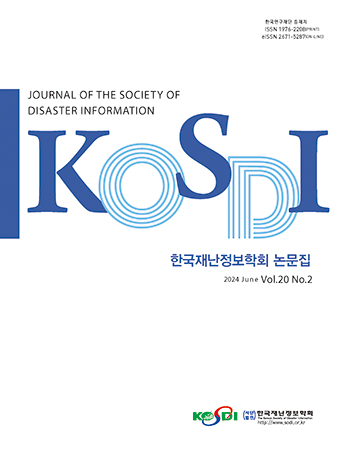Original Article
Abstract
References
Information
Purpose: Recently, large-scale forest fires caused by climate change, natural disasters, and human factors have been increasing every year in the East Coast and Taebaek Mountains region. Although forest fire extinguishing using helicopters is currently increasing, the need to introduce air force transport aircraft has continued to be raised due to the importance of early fire extinguishment to respond to large forest fires and the difficulty of extinguishing forest fires between sheep. This study seeks to present a plan for developing a post-fire management system for several aspects - achieving operational objectives, overcoming the operating environment, selecting a staging area, and efficient operation measures - to efficiently perform forest fire extinguishing missions using Air Force transport aircraft. Method: Based on literature research on forest fire extinguishing, forest fire extinguishing experiments using fixed-wing aircraft, and the operation status and operation method of forest fire extinguishing helicopters, the pros and cons of helicopter operation and the effects of large forest fire extinguishing using a large transport aircraft (C-130) Analyze the effectiveness of operation through analysis. Results: When extinguishing a large forest fire, an effective CM (Consequence Management) application plan was derived, including effective operation, control, command system, dispatch request, and forest fire extinguishment when integrating helicopter and fixed-wing aircraft (C-130). Conclusion: The application of the concept of CM (Consequence Management) is partially applied to some areas of chemical, biological, and radiological (CBRNE) protection in Korea, but efficient operation, control, and command systems are established when integrated operation of helicopters and large aircraft (C-130) in forest fire extinguishment. the concept of CM (Consequence Management), which is operated in advanced countries, was applied for safety management, dispatch requests, and forest fire extinguishing, thereby contributing to the establishment of a more advanced disaster and post-disaster management system.
연구목적: 최근 기후변화, 자연재해, 그리고 인적 요인에 의한 대형 산불이 동해안 및 태백산맥 지역에서 매년 증가하는 추세를 보인다. 현재 헬리콥터를 활용한 산불 진화가 증가하고 있음에도 불구하고, 대형 산불에 대응하기 위한 초기 진화의 중요성과 양간 산불 진화의 어려움으로 인해 공군 수송기의 도입 필요성이 지속해서 제기되어 왔다. 본 연구는 공군 수송기를 활용한 산불 진화 임무를 효율적으로 수행하기 위한 여러 측면 - 작전 목적의 달성, 운용 환경 극복, 대기 장소 선정 및 효율적 운용 방안 - 에 대한 사후 관리체계 발전 방안을 제시하고자 한다. 연구방법: 산불진화 관련 문헌연구와 고정익항공기를 활용한 산불진화 실험 및 산불진화 헬기의 운용실태 및 운용방법을 기초로 헬기운용 시 장단점 및 대형수송기(C-130)를 활용한 대형산불진화시 효과분석을 통해 운용의 효과성을 분석한다. 연구결과: 대형산불 진화 시 헬기와 고정익항공기(C-130)를 통합 운용시 효과적인 운용, 통제, 지휘체계, 출동요청 및 산불진화 등 효과적인 CM(Consequence Management) 적용방안을 도출하였다. 결론: CM(Consequence Management)의 개념 적용은 우리나라에서 일부 화생방(CBRNE) 방호 분야에 일부 적용되고 있으나 산불진화에 있어서 헬기와 대형항공기(C-130)의 통합운용 시 효율적인 운용, 통제, 지휘체계 정립, 안전관리, 출동요청 및 산불진화 등을 위해 선진국에서 운용되고 있는 CM(Consequence Management)의 개념을 적용하여 진일보 발전된 재해, 재난 사후관리체계를 정립하는 데 기여하도록 하였다.
- Bae, T.-H., Lee, S.-Y. (2015). "Efficient operation plan for forest fire extinguishing." Journal of the Korean Fire Protection Association, Vol. 29, No. 1, pp. 46-47. 10.7731/KIFSE.2015.29.1.045
- Bae, T.-H., Lee, S.-Y. (2010). "Study on the construction type and method of extinguishing fire lines for aerial fire extinguishing forest fires." Journal of the Korea Fire Protection Society, Vol. 24, No. 5, pp. 22-25.
- FM. Air Force (2018). Mobile Reconnaissance Manual (C-130 Operational Procedures) 13-201-1 (C-130).
- George, C.W. (1973). A Review of Date Available Regarding Aerial Firefighting Operation Tank and Gating System. U.S Lockheed Martin Co. Research Report, MAFFS, L.A.
- http://history.amedd.army.mil/booksdocs/vietnam/dustoff/chapter4.htm.
- Lee, S.-Y. (2018). "Development of a nationwide forest fire occurrence model." Korean Journal of Agriculture, Forestry and Forestry, Vol. 6, No. 4, pp. 242-248.
- Lee, S.-Y. (2019). Problems and Improvement Measures in Forest Fire Extinguishment. Master's Thesis. Kyungil University Graduate School of Industry. pp. 4.-5. 11.
- National Transportation Safety Board (NTSB) (2018). U.S. Forest Service Aviation Safety Report (SAFECOM), U.S AirForce, NY.
- US AirForce Forest Service (2018). Forest Statistics Yearbook.
- Publisher :The Korean Society of Disaster Information
- Publisher(Ko) :한국재난정보학회
- Journal Title :Journal of the Society of Disaster Information
- Journal Title(Ko) :한국재난정보학회논문집
- Volume : 20
- No :1
- Pages :232-243
- DOI :https://doi.org/10.15683/kosdi.2024.3.31.232




 Journal of the Society of Disaster Information
Journal of the Society of Disaster Information







